Prostate cancer: Causes, symptoms, diagnosis & treatment
Prostate cancer is a form of cancer that develops in the prostate gland of men. The disease mainly affects men over 50 and can be cured if detected early.
What is prostate cancer?
The prostate gland (also known as the prostate gland) is a gland-sized male genital gland located below the bladder and anterior rectum.
In men, this gland secretes a fluid mixed with semen during ejaculation. This substance plays a protective role and increases the ability of sperm to function, making conception easier. Like many other organs, the prostate can be attacked by cancer.
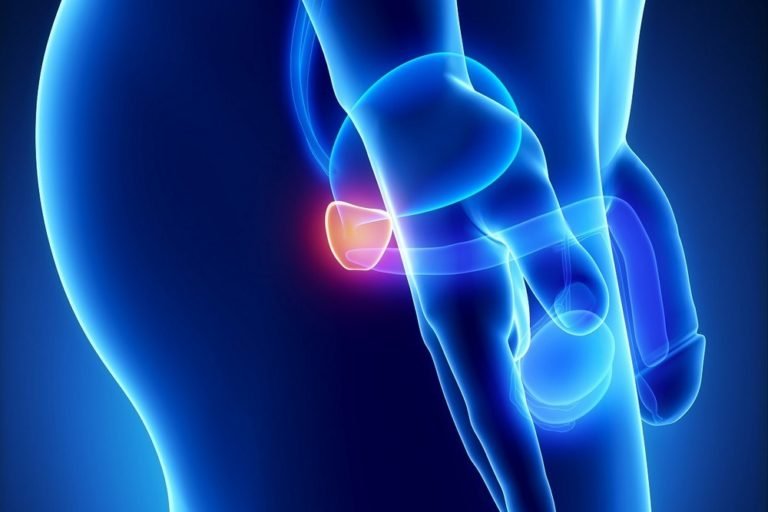
Prostate cancer can affect male fertility
Prostate cancer is a medical term used to refer to the appearance of a malignant tumor in the prostate. In the United States, this is the most common cancer among men. However, the disease has a slow progression and can be cured if diagnosed at an early stage.
Causes of prostate cancer
The exact cause of prostate cancer is not known. The researchers attributed this disease to an abnormal change in the DNA of a healthy prostate cell. Mutations in DNA promote faster growth and division of abnormal cells. They accumulate and form a malignant tumor that invades the tissues of the prostate gland.
In addition, researchers found several factors that may increase the risk of developing prostate cancer. These include:
Smoking: The toxic substances in cigarette smoke can put men at a higher risk for advanced prostate cancer. The use of tobacco after the time of cancer treatment can also promote the relapse.
Occupation: Men who work in a shaking environment are more likely to get cancer.
Age: This cancer is more common in middle-aged men, after 50 years of age
Race, geography: Statistics show that men living in North America, Northwest Europe, Australia, on the Caribbean islands and black men account for the highest incidence of prostate cancer.
Genetics: A man is twice as likely to get cancer if a twin, brother, or father has had prostate cancer in the family. In addition, if the gene carrying the gene that increases the risk of breast cancer is BRCA1 or BRCA2, men are also at higher risk of developing cancer than normal men.
Eating habits: Scientists have shown a link between a diet high in red meat or high-fat dairy products that can increase a person's chance of developing prostate cancer.
Overweight, obesity: Obesity may increase the risk of death during advanced cancer. However, researchers do not know if excess weight is associated with the onset of the disease.
Agent Orange exposure: Exposure to Agent Orange may be associated with the development of several types of cancer, including prostate cancer in men.
10 signs of prostate cancer
Prostate cancer usually progresses very slowly and is not present in its early stages. However, to the advanced stage, it causes many abnormal symptoms that directly affect the life and health of the patient.
Possible manifestations of prostate cancer include:
Urinate more often during the day and at night
Primary difficulty
Urinary retention
Hematuria, cloudy urine
Painful urination
Hard erection or unable to maintain an erect state of the penis for long periods of intercourse
There is pain in the bone. The areas most affected are the hips, spine, sides of ribs (chest), pelvis or femur.
Bones are easily broken
Thin, tired, fast weight loss people
In case of tumor metastases to the spine and compression into the marrow: The patient also manifests numbness in the legs, feet, loss of autonomy in urination activities.

Urinating several times a day is a common manifestation of prostate cancer
When should you visit a hospital?
Most of the above symptoms are most likely caused by a problem other than prostate cancer. For example, difficulty urinating more often due to benign prostatic hyperplasia (BPH) or urinary tract infections.
Therefore, you should go to the hospital to see a doctor if any of these symptoms to find the cause and appropriate treatment.
Stages of prostate cancer
Based on the location, size of the tumor and the extent of the influence, prostate cancer is divided into four stages of development:
Stage I: Cancer cells are found in the prostate, they are very small in size and have not affected the lymph nodes.
Phase II: Divided into small stages, IIA and IIB. At this time, the tumor grows a bit larger but has not spread beyond the prostate. Manual physical examination can detect tumors.
Stage III: Cancer cells have spread beyond the prostate and invaded nearby tissues. The seminal vesicles may also be affected.
Stage IV: Also known as advanced stage prostate cancer. By now, cancer cells have spread to lymph nodes and other organs.
The prognosis for a person living with prostate cancer
If the disease is diagnosed early before the cancer cells spread to other organs, the 5-year survival rate is quite high, about 99%. Cancer discovered after 15 years, the rate dropped to 96%. In case of metastatic prostate cancer, the patient's 5-year survival rate is only about 29%.
The sooner it is detected, the greater the likelihood of the patient's success of treatment and the chance of him or her living for more years. Therefore, when there are signs of doubt or among high-risk cancer groups, men should have regular screening, PSA test to measure prostate cancer index to detect and treat the disease. timely.
How to diagnose prostate cancer
Techniques used by a doctor to diagnose prostate cancer include:
- Check medical history:
If you suspect you have prostate cancer, your doctor will ask you to share all the symptoms you are experiencing and when they will appear, including urinary or sexual problems. You may also be asked by your doctor about your family history, illness, and career to determine risk factors for cancer.
- Manual rectal exam (DRE):
The doctor wears gloves and lubricates a fingertip into the rectum. This will help spot any signs of a bump or a lump in the prostate that could be cancer.
In the case of cancer, sometimes a manual rectal exam can also help determine the extent of the cancer. For example, cancer is only on one side of the prostate or both, or has the cancer spread to the outside?
After a physical examination, your doctor may continue to order additional tests for prostate cancer such as:
- PSA test:
PSA are specific antigens of the prostate. If PSA level is> 4ng / ml of blood, prostate cancer may be suspected. If PSA is> 10ng / ml blood, the chance of getting prostate cancer is over 50%.
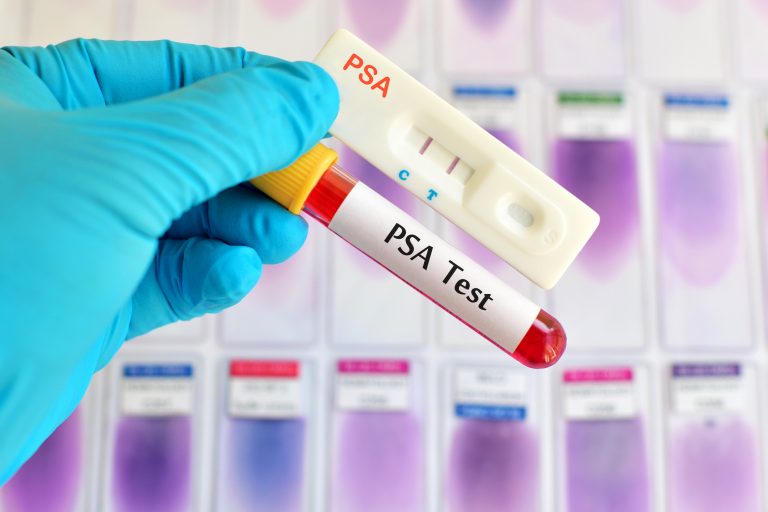
PSA is a prostate cancer test that helps detect disease at an early stage
The PSA test is also the technique used to screen for cancer in men who have no signs of prostate cancer.
- Ultrasound through the rectum (trust):
This method will be ordered when the patient has a high prostate cancer index (PSA) or DRE examination for abnormal results. A small probe about the same size as a finger is lubricated and inserted into the prostate gland through the rectum.
Black-and-white images recorded on the computer allow the doctor to assess the situation inside the prostate gland.
- Prostate biopsy:
Through ultrasound, the doctor may use a biopsy needle to take about 12-14 tissue samples from different areas of the prostate and examine them under a microscope to check the presence of cancer cells.
In addition to the aforementioned prostate cancer diagnostic techniques, a specialist may order a lymph node biopsy or imaging tests such as bone scan, CT scan, MRI or X-ray. They help determine the extent of spread and metastasis of cancer cells.
Treatments for prostate cancer
Through the diagnosis, the doctor will determine the extent and stage of the cancer. From there, decide on the appropriate treatment method for each patient.
# Treatment for prostate cancer in the early stages:
If the tumor is small or has not spread to the prostate, the cancer can be managed and treated with the following methods:
- Subscribe and wait:
Not all cases of prostate cancer require immediate treatment. The reason is that the risk of side effects is sometimes even greater than the benefits gained when treating cancer in the advanced stage.
The doctor will carefully consider a number of factors such as age, overall health, cancer problems caused to the patient, benefits and risks of treatment. At the same time, regularly check your blood to monitor PSA levels before deciding what to do.
- Surgery:
The doctor will remove the entire prostate gland and some of the tissue surrounding it, including the seminal vesicle. Surgical methods for prostate removal include:
Open surgery: Patients who are operated on this traditional method usually need to stay in the hospital for a maximum of 10 days and need about 3 months to recover.
Endoscopic surgery: The removal of the prostate gland is done through a number of small incisions so it causes less pain and bleeding. The hospital stay is shorter.
Robotic arm surgery: Although this method is highly accurate, the recovery time is fast but quite expensive.
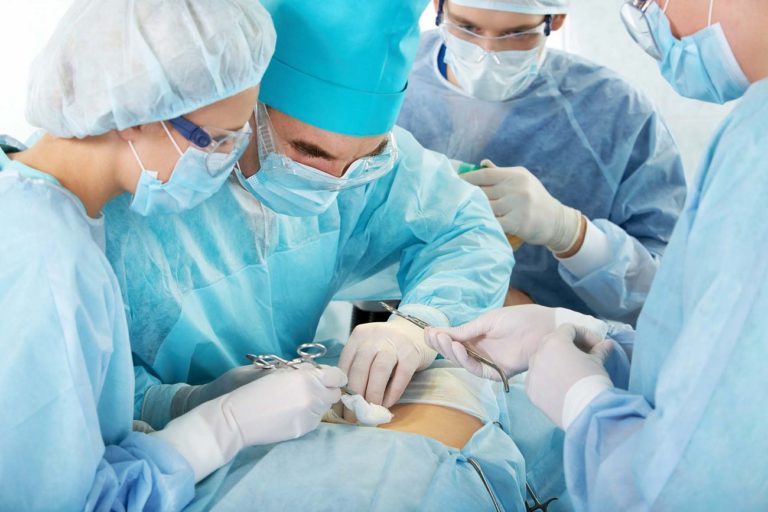
Surgery is a commonly prescribed method to treat early prostate cancer
Some risks that patients face after prostate cancer surgery are: Allergy to anesthetics, high blood loss, urinary incontinence, deep vein thrombosis in the legs or lungs, wound infection, hurt nearby organs ...
In addition, the removal of the prostate gland can reduce sperm production and fertility. If you still want to have children, you can talk to your doctor about sperm storage or take sperm extracted directly from the testes for artificial insemination. However, the likelihood of success is not guaranteed.
- Treatment of prostate cancer with radiation therapy (Brachytherapy):
The radioactive material will be implanted in the prostate to kill cancer cells in the affected area. This method has few side effects, but patients may experience pain and swelling at the treatment site.
- 3D radiation therapy (3D - CRT):
3D-CRT uses specialized computer software to accurately map tumor locations in the prostate gland. The radiation beam is then shaped and aimed at the prostate gland from multiple directions to destroy cancer cells. Therefore, this method is less likely to damage healthy tissue.
- High intensity radiation therapy (IMRT):
IMRT is an advanced form of 3D therapy. The doctor manipulates the device to shape the beam and aim them at the prostate gland from many angles. The intensity of the beam can be changed to limit the dose of access to nearby normal tissue. This allows doctors to provide a higher dose of radiation to the cancer site.
Some side effects that patients may experience when radiotherapy for prostate cancer include: Diarrhea, bloody bowel movements, rectal leakage, cystitis, burning pain when urinating, urinary incontinence, stenosis urethra, fatigue, lymphedema, loss of erection leading to impotence ...
In the early stages, patients can also be treated for prostate cancer with cryotherapy or radiotherapy in combination with hormone therapy for a period of approximately 4 to 6 months. Discuss with your doctor all the benefits and risks of treatments to choose the most appropriate solution.
# Treatment of prostate cancer in advanced stage
As the cancer progresses, malignant cells may spread throughout the body. The following treatments may be recommended:
- Valence:
Chemotherapy uses intravenous or oral anticancer drugs. The drug is able to penetrate into the bloodstream and travel throughout the body to kill malignant cells, so it is helpful for cases of prostate cancer that has spread to distant organs.
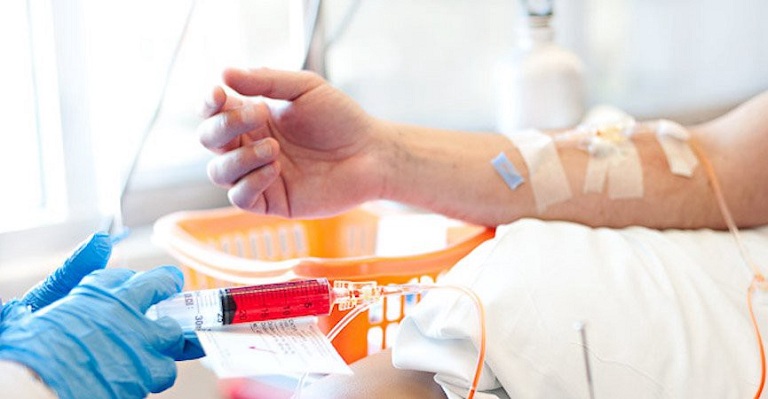
Patients with metastatic prostate cancer may be prescribed chemotherapy
Some chemotherapy drugs commonly used in the treatment of prostate cancer include:
Docetaxel (Taxotere)
Cabazitaxel (Jevtana)
Mitoxantrone (Novantrone)
Estramustine (Emcyt)
In most cases, the first chemotherapy drug given was Docetaxel, combined with steroid medicine. If the patient does not respond to the above medication, Cabazitaxel may be the next option. Both of these drugs have been shown to slow cancer growth, improve symptoms and help men live longer than older chemotherapy drugs. However, chemotherapy alone is unlikely to cure metastatic cancer.
Chemotherapy for prostate cancer is usually done in cycles. After each course of chemotherapy is given, the patient has a few weeks of rest to help the body recover before the next chemotherapy cycle.
Depending on the medication, dosage and duration of chemotherapy, the patient may experience side effects such as:
Alopecia
Mouth ulcers
Eating is not good, anorexia
Nausea and vomiting
Diarrhea
Reducing white blood cells and platelets should be prone to infections, bruising of the skin
Fatigue, lack of vitality
After treatment, these side effects may disappear. Your doctor will prescribe a number of medications to help alleviate unwanted effects for patients.
- Hormone therapy to treat prostate cancer:
Hormone therapy is also known as androgen suppressant therapy and androgen deficiency (ADT) therapy. This method is used to reduce the level of male androgen hormones in the body or prevent it from stimulating the growth of cancer cells. As a result, cancer cells may shrink or stop growing for a while.
Patients often require long-term hormone therapy. However, this therapy may stop working after a while and need to choose another way to deal with cancer.
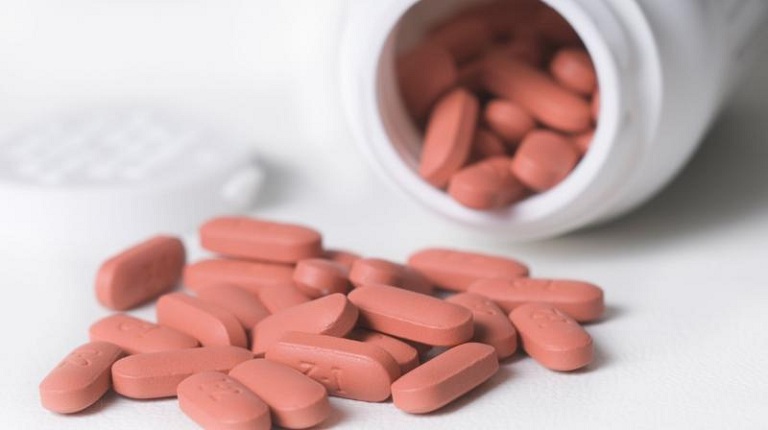
Taking androgen inhibitors may help slow the progression of prostate cancer
Possible side effects of hormone therapy include:
Decreased libido or a complete loss of libido
Erectile dysfunction, impotence
Shrinkage of testicles and penis
Breast tissue development
Osteoporosis, fractures
Reducing red blood cells leads to anemia
Weight gain, fatigue, anxiety
Flushing…
In the process of curing prostate cancer, men should keep optimism, exercise regularly to improve health. It is necessary to consult a doctor for diet advice, palliative care after cancer treatment.
Can prostate cancer be prevented?
There is no absolute cure for this disease. However, men can reduce the risk of prostate cancer in the following ways:
Follow a healthy diet: A diet that includes lots of green vegetables, fruits, whole grains and cut back on fat-rich foods will contribute to improved health, helping men prevent cancer in the gland. prostate.
Exercise every day: Exercise regularly helps maintain heavy, improve mood and improve overall health, thereby reducing risk factors for cancer. Men should maintain a daily exercise routine. Start familiarizing yourself with light, moderate exercises and gradually increase the intensity of your practice.
Lose weight if you are obese: If you are overweight, consult your doctor to develop a diet plan, exercise science to lose weight safely.
Routine cancer screening: This is essential, especially if you have one of the risk factors for developing prostate cancer mentioned above.
In general, prostate cancer has a good prognosis, high cure ability if diagnosed before metastasis. Therefore, do not hesitate to visit if you have any suspicious signs. Some reputable specialized hospitals you can look to screen and screen for prostate cancer such as Bach Mai hospital, K hospital, Da Nang Oncology hospital, Ho Chi Minh City oncology hospital.
The information provided in this article is for reference only. There is no substitute for a doctor's diagnosis and medical treatment.
VACXIN VIETNAM JOINT STOCK COMPANY
Certificate of Business Registration No. 0107631488 by the Department of Planning and Investment City. Hanoi issued on 11/11/2016
Address: 180 Truong Chinh, Khuong Thuong Ward, Dong Da District, City. Hanoi
Mail: info@mode.edu.vn
Hotline: 028 7300 6595
Working time: From Monday to Sunday
From 7:30 - 17:00 (no lunch break)
117-119 Ly Chinh Thang, Ward 7, District 3, City. Ho Chi Minh